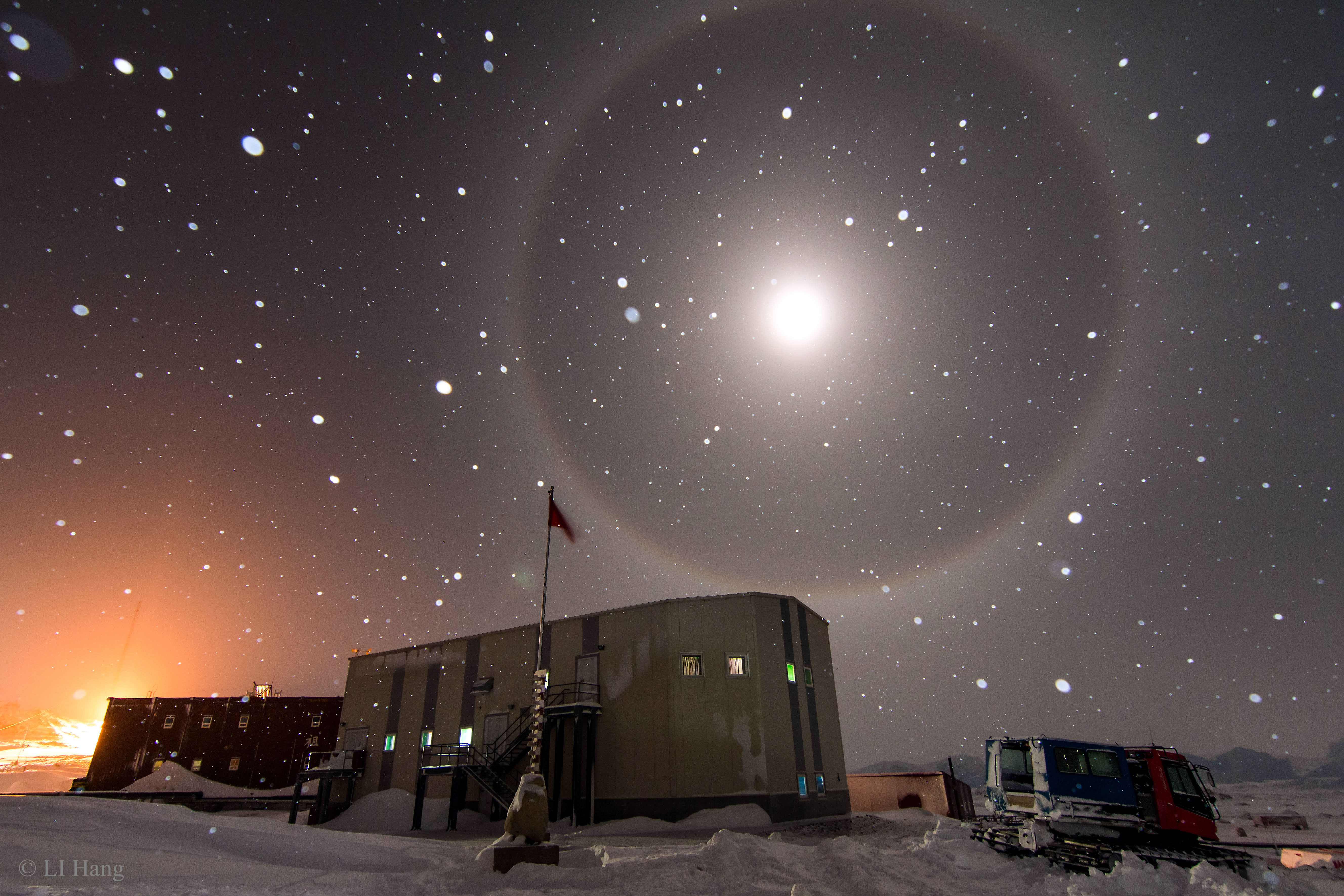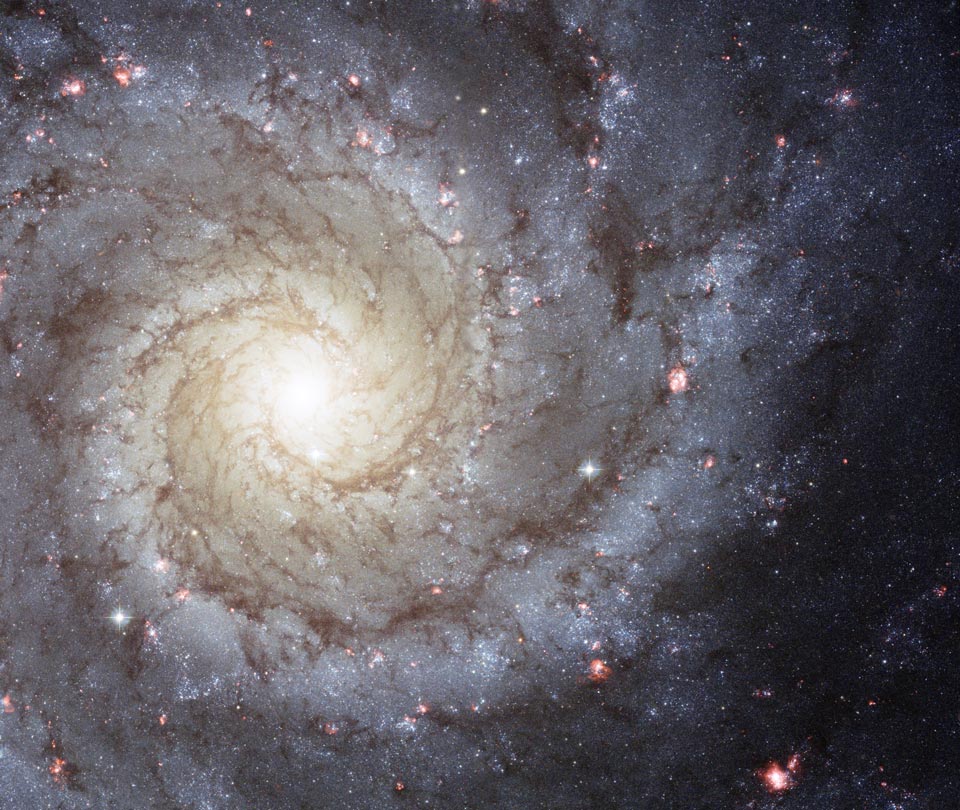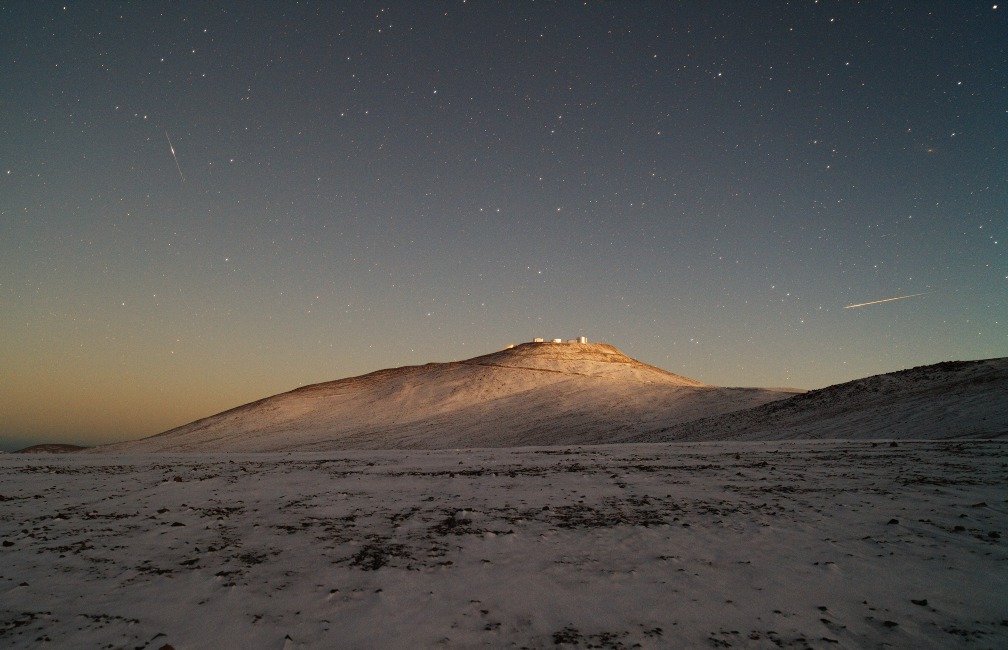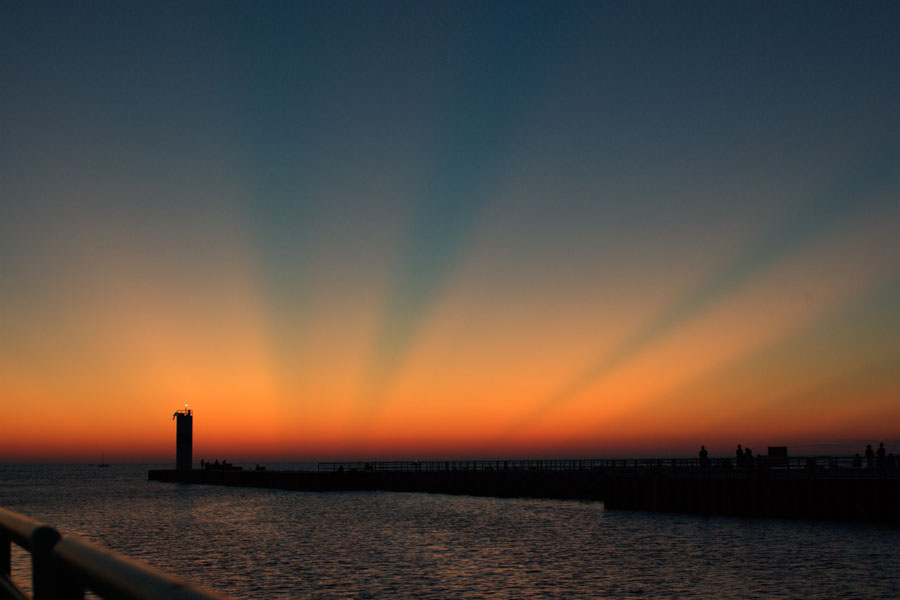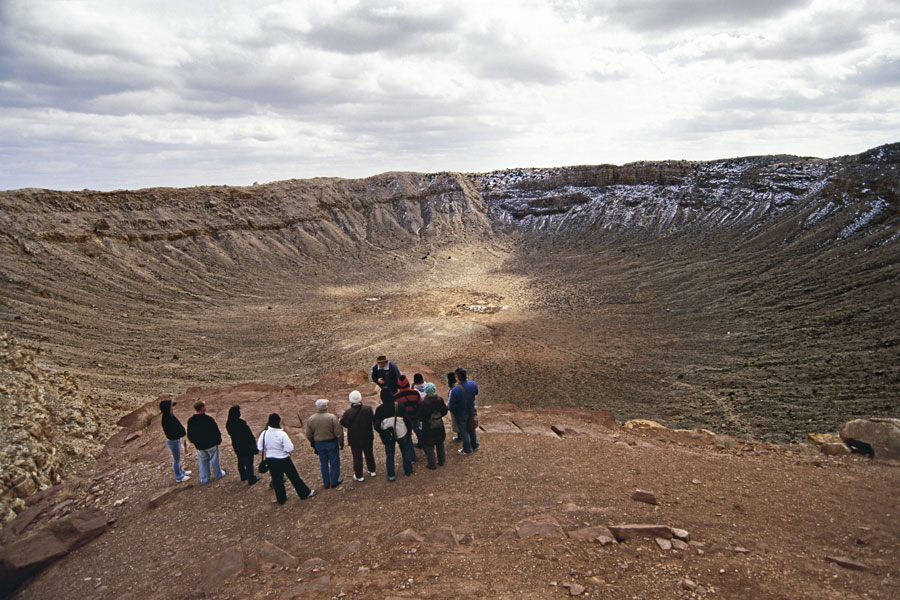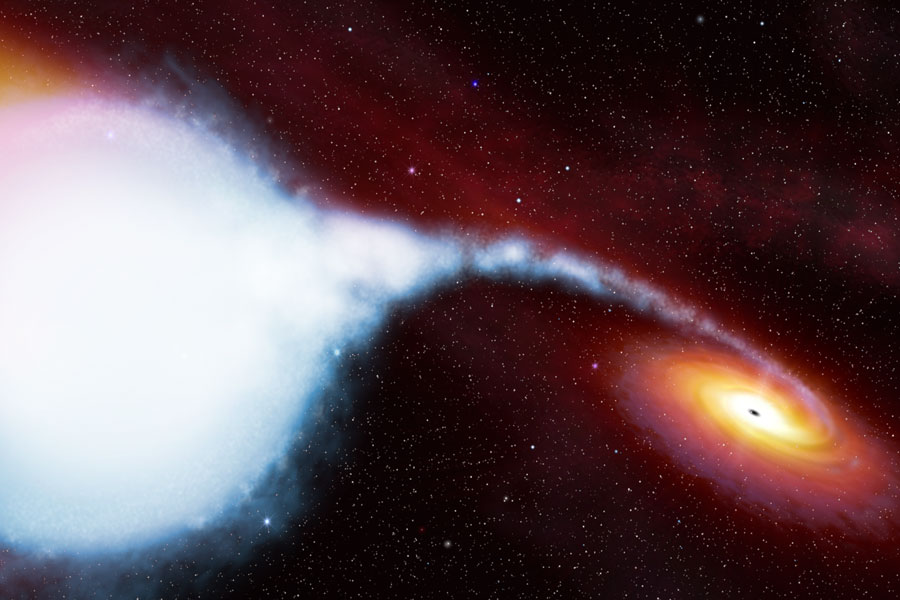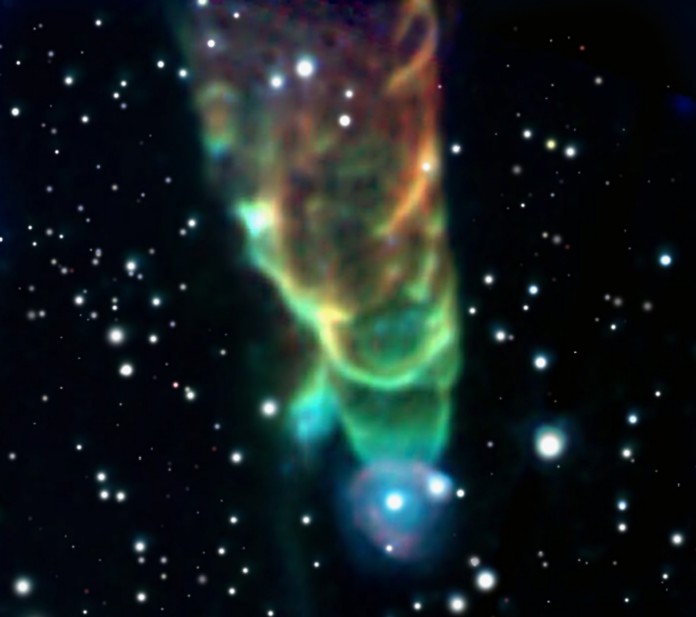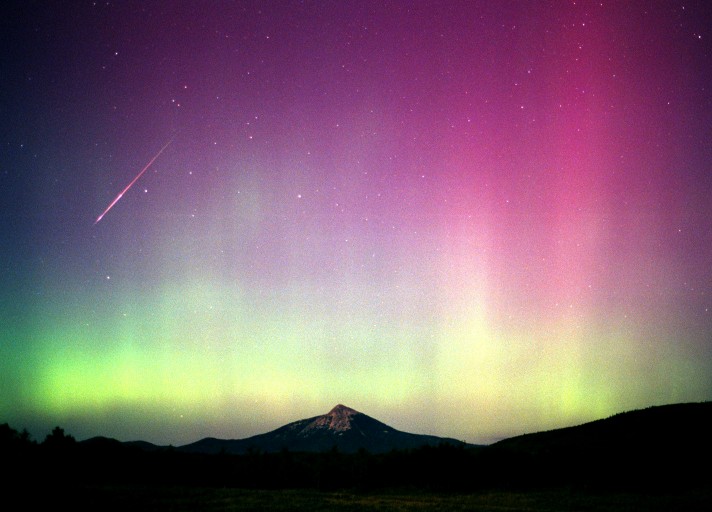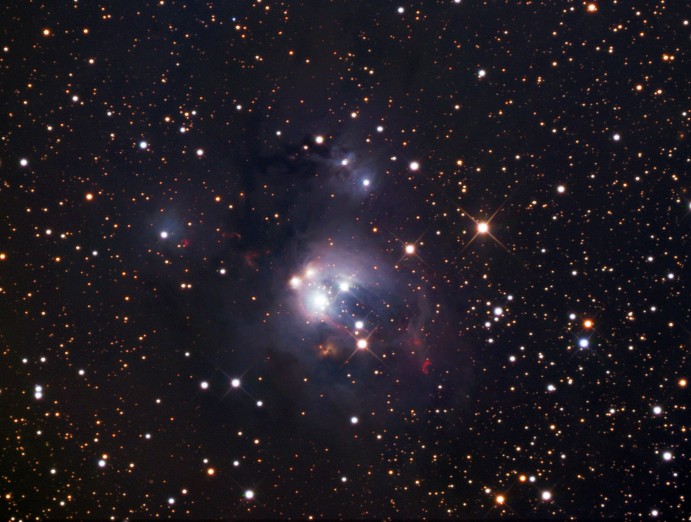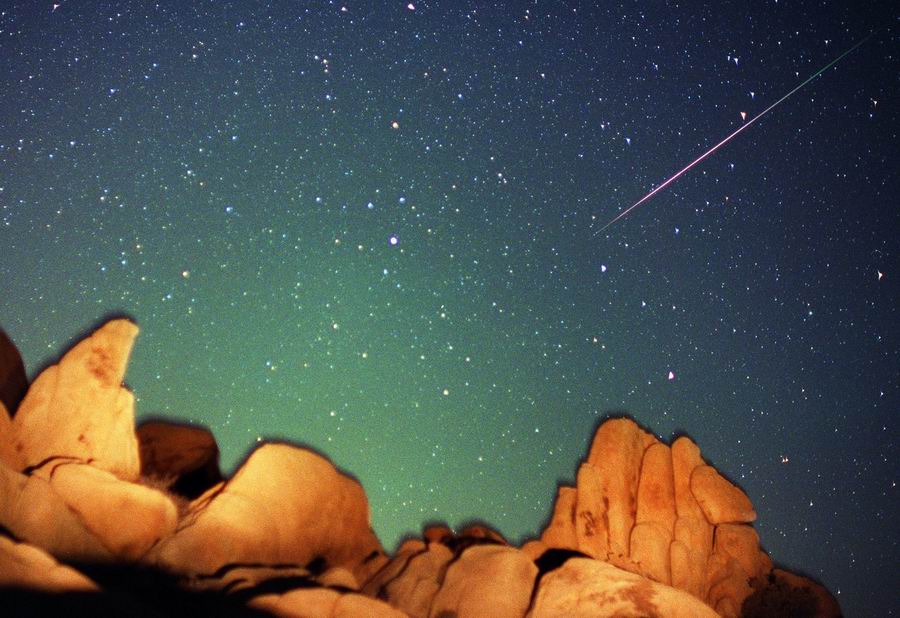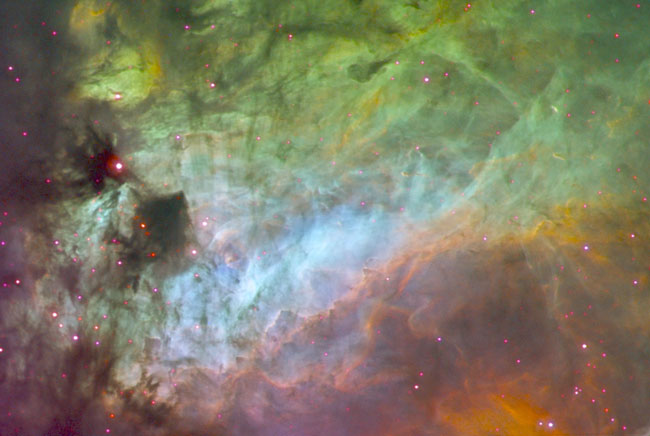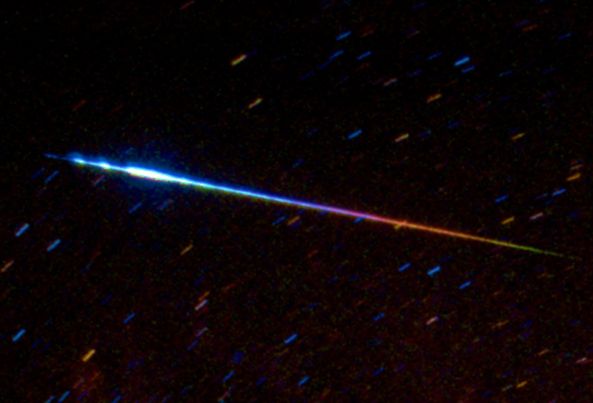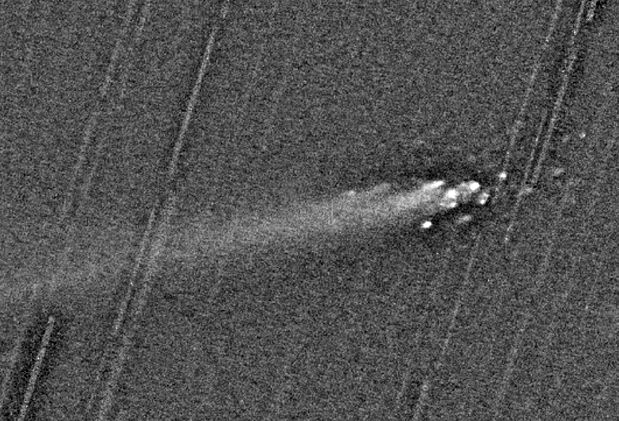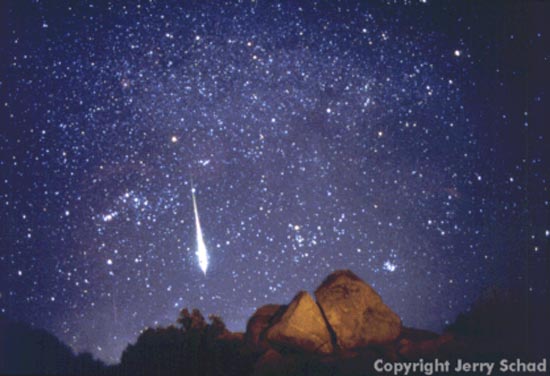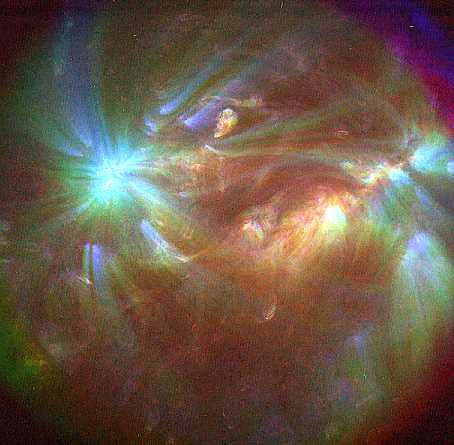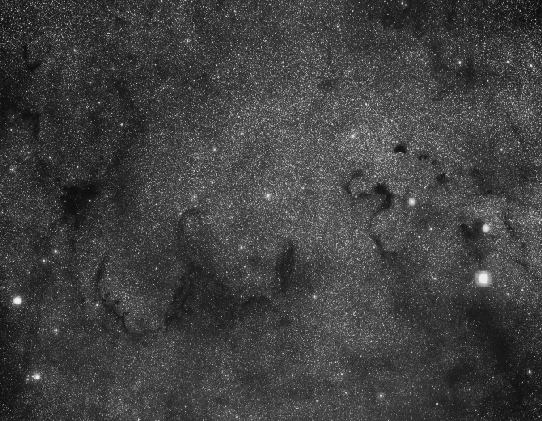| << Previous | Index | Next >> |
2015 Have you ever seen a halo around the Moon? Such 22 degree rings around the Moon -- caused by ice crystals falling in the Earth's atmosphere -- are somewhat rare. OK, but have you ever seen a blue moon? Given the modern definition of blue moon -- the second full moon occurring in a calendar month -- these are also rare. What is featured above might therefore be considered doubly rare -- a halo surrounding a blue moon. The featured image was taken late last month near Zhongshan Station in Antarctica. Visible in the foreground are a power generating house and a snowmobile. What might seem to be stars in the background are actually illuminated snowflakes near the camera.
2014
Click to play embedded YouTube video.
Image Credit & Copyright: ESA, Rosetta spacecraft, NavCam imager; Music: Eine kleine Nachtmusik (Mozart)
2013
2012 You've just landed on Mars and opened your eyes -- what do you see? If you're the Curiosity rover, you see a strange gravelly place with a large mountain in the distance. You've landed on target near the edge of 150-km wide Gale Crater, with Mount Sharp on the horizon being the rise in the crater's center. As a car-sized rover with six wheels and a laser, you prepare yourself to go on a two-year mission of exploration, climbing Mt. Sharp, and looking for signs that Mars once harbored life. Currently you sit motionless, check yourself over, and receive a detailed briefing from Earth on things you will need to know while rolling around, trying to avoid flipping over or getting your wheels stuck in sand. Your rolling explorations will likely start in a few days. What will you find? What's out there?
2011 Recorded last week, this dawn portrait of snowy mountain and starry sky captures a very rare scenario. The view does feature a pristine sky above the 2,600 meter high mountain Cerro Paranal, but clear skies over Paranal are not at all unusual. That's one reason the mountain is home to the European Southern Observatory's Very Large Telescope. Considering the number of satellites now in orbit, the near sunrise streak of a satellite glinting at the upper left isn't rare either. And the long, bright trail of a meteor can often be spotted this time of year too. The one at the far right is associated with the annual Perseid meteor shower whose peak is expected tomorrow (Friday, August 12). In fact, the rarest aspect of the picture is just the snow. Cerro Paranal rises above South America's Atacama desert, known as the driest place on planet Earth.
2010 What could cause such rays of dark? Dark sky rays were caught in spectacular fashion earlier last month from Pentwater, Michigan, USA, looking west over Lake Michigan. The cause is something surprisingly familiar: shadows. Clouds near the horizon can block sunlight from reflecting off air, making columns outward from the Sun appear unusually dark. Cloud shadows can be thought of as the complement of the more commonly highlighted crepuscular rays, also visible above, where sunlight pours though cloud holes. Sometimes, on the opposite side of the sky, anticrepuscular rays can also be seen.
2009 What happens when a meteor hits the ground? Usually nothing much, as most meteors are small, and indentations they make are soon eroded away. About 50,000 years ago, however, a large meteor created Barringer Meteor Crater in Arizona, USA. Also known simply as Meteor Crater, the resulting impact basin spans over a kilometer. Pictured above, a tour group views the inside of Barringer Crater early last year. Historically, Barringer Crater was the first feature on Earth to be recognized as an impact crater. Today, over 100 terrestrial impact features have been identified on planet Earth. Computer modeling indicates that some of the Canyon Diablo impactor melted during the impact that created Barringer.
2008 Is that a black hole? Quite possibly. The Cygnus X-1 binary star system contains one of the best candidates for a black hole. The system was discovered because it is one of the brightest X-ray sources on the sky, shining so bright it was detected by the earliest rockets carrying cameras capable of seeing the previously unknown X-ray sky. The star's very name indicates that it is the single brightest X-ray source in the constellation of the Swan Cygnus. Data indicate that a compact object there contains about nine times the mass of the Sun and changes its brightness continually on several time scales, at least down to milliseconds. Such behavior is expected for a black hole, and difficult to explain with other models. Pictured above is an artistic impression of the Cygnus X-1 system. On the left is the bright blue supergiant star designated HDE 226868, which is estimated as having about 30 times the mass of our Sun. Cygnus X-1 is depicted on the right, connected to its supergiant companion by a stream of gas, and surrounded by an impressive accretion disk. The bright star in the Cygnus X-1 system is visible with a small telescope. Strangely, the Cygnus X-1 black hole candidate appears to have formed without a bright supernova explosion.
2007 Light-years in length, this cosmic tornado is actually a powerful jet cataloged as HH (Herbig-Haro) 49/50 blasting down from the top of a Spitzer Space Telescope view. Though such energetic outflows are well known to be associated with the formation of young stars, the exact cause of the spiraling structures apparent in this case is still mysterious. The embryonic star responsible for the 100-kilometer per second jet is located just off the top of the picture, while the bright star seen near the tip of the jet may just by chance lie along the line of sight. In the false-color infrared image, the tornado glows with infrared light generated as the outflow heats surrounding dust clouds. The color coding shows a trend from red to blue hues at the tornado's tip indicating a systematic increase in emission at shorter wavelengths. The trend is thought to indicate an increase in molecular excitation closer to where the head of the jet is impacting interstellar gas. HH49/50 is about 450 light-years distant, located in the Chamaeleon I molecular cloud.
2006 Dark skies are favored for viewing meteor showers -- so many are pessimistic about this year's Perseids. While the Perseid meteor shower is scheduled to peak this weekend, bright light from an almost full Moon will also flood the night and mask the majority of relatively faint meteors. Still, skygazing in the evening before the Moon rises (before about 10 PM local time) could reveal spectacular earthgrazing meteors. Persisting even later into the moonlit night can reward northern hemisphere watchers looking for occasional Perseid fireballs. In fact, astronomer Jimmy Westlake imaged this bright Perseid meteor despite the combination of moonlight and auroral glow over Colorado skies in August of 2000.
2005 Young suns still lie within dusty NGC 7129, some 3,000 light-years away toward the royal constellation Cepheus. While these stars are at a relatively tender age, only about a million years old, it is likely that our own Sun formed in a similar stellar nursery some five billion years ago. Most noticeable in the striking image are the lovely bluish dust clouds that reflect the youthful starlight, but the smaller, deep red crescent shapes are also markers of energetic, young stellar objects. Known as Herbig-Haro objects, their shape and color is characteristic of glowing hydrogen gas shocked by jets streaming away from newborn stars. Ultimately the natal gas and dust in the region will be dispersed, the stars drifting apart as the loose cluster orbits the center of the Galaxy. NGC 7129 is about 10 light-years across.
2004 The ongoing Perseid Meteor Shower should be at its strongest tonight and tomorrow night. Although meteors should be visible all night long, the best time to watch will be between 2:00 AM and dawn each night. In dark, moonless, predawn skies you may see dozens of meteors per hour. Sky enthusiasts in Europe and Asia might see an unusual burst of meteors near 2100 hours UT. Grains of cosmic sand and gravel shed from Comet Swift-Tuttle will streak across the sky as they vaporize during entry into Earth's atmosphere. Tracing the meteor trails backwards, experienced skygazers will find they converge on the constellation Perseus, thus this annual meteor shower's name. Pictured above is a Perseid meteor from 2002 over a rock formation in the US Southwest desert. Shadowing and blurring are caused by the long 10-minute exposure. The brightest Perseids can be seen from anywhere on Earth by monitoring the continuously returning images from the Night Sky Live cameras.
2003 In the depths of the dark clouds of dust and molecular gas known as M17, stars continue to form. Also known as the Omega Nebula and Horseshoe Nebula, the darkness of M17's molecular clouds results from background starlight being absorbed by thick filaments of carbon-based smoke-sized dust. As bright massive stars form, they produce intense and energetic light that slowly boils away the dark shroud. Colors in the above image were picked to highlight specific elements that emit nebular light: red indicates emission from sulfur, green from hydrogen, and blue from oxygen. The Swan Nebula is visible with binoculars towards the constellation of Sagittarius, lies 5000 light-years away, and spans 20 light-years across.
2002 The ongoing Perseid Meteor Shower should be at its strongest on August 12 and 13. The best time to watch will be between 2:00 AM and dawn on Monday morning (so plan on setting your alarm tonight!) and then again on Tuesday. In dark, moonless, predawn skies you may see dozens of meteors per hour. Grains of cosmic sand and gravel shed from Comet Swift-Tuttle will streak across the sky as they vaporize during entry into Earth's atmosphere. Tracing the meteor trails backwards, experienced skygazers will find they converge on the constellation Perseus, thus this annual meteor shower's name. Pictured above is a Perseid meteor from 1993. The colors are representative but digitally enhanced. As the meteor streaked across the night sky, different excited atoms emitted different colors of light. The origin of the green tinge visible at the right is currently unknown, however, and might result from oxygen in Earth's atmosphere.
2001 Gamma rays are the most energetic form of light, packing a million or more times the energy of visible light photons. If you could see gamma rays, the familiar skyscape of steady stars would be replaced by some of the most bizarre objects known to modern astrophysics -- and some which are unknown. When the EGRET instrument on the orbiting Compton Gamma-ray Observatory surveyed the sky in the 1990s, it cataloged 271 celestial sources of high-energy gamma-rays. Researchers identified some with exotic black holes, neutron stars, and distant flaring galaxies. But 170 of the cataloged sources, shown in the above all-sky map, remain unidentified. Many sources in this gamma-ray mystery map likely belong to already known classes of gamma-ray emitters and are simply obscured or too faint to be otherwise positively identified. However, astronomers have called attention to the ribbon of sources winding through the plane of the galaxy, projected here along the middle of the map, which may represent a large unknown class of galactic gamma-ray emitters. In any event, the unidentified sources could remain a mystery until the planned launch of the more sensitive Gamma-ray Large Area Space Telescope in 2005.
2000 What do you call a bunch of comet fragments anyway ... a flock, a covey, a swarm? The question is definitely relevant to comet LINEAR (C/1999 S4 LINEAR) whose nucleus apparently fragmented late last month during its first trip through the inner solar system. This computer enhanced composite image shows faint stars as trails and the remnants of LINEAR's nucleus as a flock of "mini-comets" embedded in a cloud of gas and dust. It was recorded by astronomers using the European Southern Observatory's Antu telescope about a day after the Hubble Space Telescope (HST) was also able to image the covey of condensations. A comparison of the HST and the subsequent Antu images reveals that the swarm of cometary debris has changed markedly in 24 hours demonstrating the very dynamic behavior of comet LINEAR's remains. Astronomers intend to keep watching as comet LINEAR's fragments continue to lose dust and gas and fade from view. As a result, LINEAR's legacy may well be insight into the make-up of a primordial piece of our solar system. If pictures of comet LINEAR have piqued your curiosity about fragments of a comet, why not watch the Perseid meteor shower this weekend?
1999 Meteors will be flashing across your skies over the next two nights. Specifically, the Perseid Meteor Shower should be at its best just before each morning's dawn. Observers at dark locations might see as much as a meteor a minute. Perseid meteors are bits of dirt that blew off Comet Swift-Tuttle and that burn up as they fall to Earth. Exciting expectations of a new filament in the Perseids might be tested this year. Pictured above is a meteor from the most active meteor shower of last year: the Leonids. Pictured above, a Leonid meteor was caught in November outshining even the brightest stars over the Anza-Borrego Desert in California. The Leonids will peak again this November and might provide an ever better show.
1998 Hot gas dances across the surface of the Sun in this picture from the orbiting TRACE satellite. The temperature of the gas is color coded so that blue represents hundreds of thousands of Kelvin, while red represents extreme temperatures in the millions of Kelvin. Hot gas is channeled into lanes ordered by the Sun's chaotic magnetic field. Pictures like these have shown that plasma heating occurs in relatively small regions.
1997 Tonight the Perseid Meteor Shower reaches its maximum. Grains of rocky ice will streak across the sky as they evaporate during entry into Earth's atmosphere. These ice chips were shed from Comet Swift-Tuttle. The Perseids result from the annual crossing of the Earth through Comet Swift-Tuttle's orbit. The Perseids are typically the most active meteor shower of the year. In a clear dark sky, an observer might see a meteor a minute. Pictured above is a Perseid meteor from 1993. The colors are representative but digitally enhanced. As the meteor streaked across the night sky, different excited atoms emitted different colors of light. The origin of the green tinge visible at the right is currently unknown, however, and might result from oxygen in Earth's atmosphere. Perseid meteors can best be seen from a relaxing position, away from lights.
1996 What slithers there? The dark curly lanes visible in part of the constellation Ophiuchus belong to the Snake Nebula. The Snake Nebula is a series of dark absorption clouds. Interstellar dust grains - composed predominantly of carbon - absorb visible starlight and reradiate much of it in the infrared. Infrared is a band of light so red humans can't see it. This absorption causes stars in the background to be blocked from our view - and hence the appearance of noticeable voids on the sky.
1995 The Compton Gamma Ray Observatory (CGRO) was the most massive instrument ever launched by a NASA Space Shuttle and continues to revolutionize gamma-ray astronomy. This orbiting observatory sees the sky in gamma-ray photons - light so blue humans can't see it. These photons are blocked by the Earth's atmosphere from reaching the Earth's surface. Results from CGRO have shown the entire universe to be a violent and rapidly changing place - when viewed in gamma-rays. Astronomers using CGRO data continue to make monumental discoveries, including showing that mysterious flashes of gamma-rays are much more powerful than previously imagined, discovery of a whole new class of QSO, and discovery of objects so strange that astronomers can't yet figure out what they are.
| << Previous | Index | Next >> |
